Hide Beetles Can be Found on Animal Carcasses
By Chris Williams on February 8, 2012.
Q. We recently had a dead squirrel in our attic. When my husband finally found the body, there wasn’t much left of it but there were a number of black beetles on the body. Were they feeding on it? Where did they come from?
A. There are a number of insects that will feed on animal carcasses in different stages of decay. Besides the blow flies whose maggots feed on the fresh carcass, there are a number of different dermestid beetles that move in later to clean the flesh and hair from the bones. The dermestid beetle most often associated with dead animals is the hide beetle.
The hide beetle is dark-brown to black with a white underside. It is elongate oval in shape and about 1/3 inch long. Hide beetle larvae are brown, worm-like but with 6 short legs, and are very hairy. They have two curved projections at the rear of their abdomens.
 Hide beetles are natural scavengers – both adults and larvae will feed on hides, furs, meats, anything of animal origin. But they don’t like fresh meat, they prefer their meats somewhat dried. Like their close relative, the larder beetle, hide beetles are not as common as they were before refrigeration when meats were dried or cured. But they can still be major pests in places like museums, taxidermy shops, meat lockers, tanneries, and poultry houses where they feed on dead chickens, droppings, chicken feed, and feathers. In homes, they’re most often traced to old animal carcasses or animal nests in attics or wall voids. They can also be found infesting accumulations of dead insects such as dead cluster flies in an attic.
Hide beetles are natural scavengers – both adults and larvae will feed on hides, furs, meats, anything of animal origin. But they don’t like fresh meat, they prefer their meats somewhat dried. Like their close relative, the larder beetle, hide beetles are not as common as they were before refrigeration when meats were dried or cured. But they can still be major pests in places like museums, taxidermy shops, meat lockers, tanneries, and poultry houses where they feed on dead chickens, droppings, chicken feed, and feathers. In homes, they’re most often traced to old animal carcasses or animal nests in attics or wall voids. They can also be found infesting accumulations of dead insects such as dead cluster flies in an attic.
It seems insects can always find their way into a home if there’s something there to attract them. Be assured that your home has plenty of tiny openings around the roof line that an insect can use to get into the attic. Hide beetles can fly. They are attracted to odors from the decaying carcass, and also to pheromones secreted by male beetles that have already found the site. Adult hide beetles usually arrive several days after death, after the flies have already done their job.
Hide beetles are very important in forensic entomology. They are used to help determine the time of death of a human corpse that is found under questionable circumstances. Entomologists know the life cycle of this insect at different temperatures and humidity. They can work backwards when hide beetles are found at a scene of death to determine just how many days ago the eggs were laid, and can then extrapolate to determine when the victim died.
On average, it takes several weeks for the entire hide beetle life cycle from laid eggs to adult beetles. When the larvae are fully developed, they wander away from the carcass looking for protected places where they can complete development. They sometimes damage wood, cork, plaster, books, and fabrics when they bore into these materials to pupate. Hide beetles have been known to cause serious structural damage to poultry houses when thousands of larvae are burrowing into wood supports.
Hide beetles can be pests in museums if they get into displays or collections where they can damage hides, furs, feathers, etc. They can easily destroy a stuffed animal diorama or a display of native Indian headdresses, for example. But at the same time, hide beetles are often kept or purchased by museums and used by curators to clean skeletons for study or display. The beetles will devour every bit of hide, tissue, and sinew leaving behind a perfectly clean, intact skeleton!